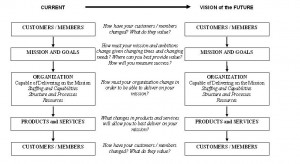Are your weaknesses controlling your course like rocks in a channel? Do your most energetic employees set the direction of your company with their energy alone? Or perhaps you tend to scurry after your competition or are propelled by the whims and ambitions of your biggest customer. Is the latest customer crisis or financial disappointment readily discernable in your list of key initiatives? Government regulations, rising energy costs, and many other external factors may be pushing you in various directions as well.
Like tortuous rapids, these formidable forces can send you down a shute you never intended to navigate.
While each of the forces mentioned is a legitimate input to strategic discussions, none should be able to swing the direction of your company out of the blue. But if you don’t have a strong, intentional strategy to guide your decisions, any one of these could become the current that dictates your course.
The core of any strategy involves determining:
- What you will provide
- To whom
- At what price
- In what quantity
- For what projected profit
- Now and in the future
This is the obvious part.
The less obvious, frequently neglected, part of developing a strategy involves determining the type of organization you want to be and the capabilities you need in order to deliver that value reliably. Collectively, this set of decisions defines a strategic framework to guide most other decisions. These decisions reach right down to daily details since all of your resources need to be directed at one of two things:
- Delivering value to customers
- Becoming the organization capable of delivering future value to customers
Without this clarity, every operational challenge threatens to swamp your strategy and every random force has the potential to distract you from those two imperatives.
For example, when equipment breaks down, the strategic framework drives the decision to replace or repair because it addresses both immediate and future priorities. When you hire one qualified candidate over another, you are selecting future company strengths. When you improve one process over another you are deciding which process is most important to the future of the company.
And when you react to an event, you are either caving in or doing something that was already in the plan. A rock in the channel should either dash strategic assumptions, driving you back to the drawing board, or be expected, at least more or less, and thus cause no more than a ripple that is resolved according to plan.
To determine how susceptible you are to being swept away by the current, answer the questions below.
- Do you know in what way your products, services and relationships provide a competitive advantage now?
- Are you taking action to protect that advantage and to prevent the inevitable slide to normalcy?
- Do you know where you expect to build an advantage going forward and the expected financial outcomes of doing so?
- Have these decisions been informed by external factors, customer needs, and your own strengths?
- Do you know what organizational capabilities are critical for delivering current and future value?
- Do you have a business process model and supply chain model that makes your strategy profitable?
- Could your managers describe the strategy briefly and clearly?
- Are there plans and accountabilities established to develop the future value and advantage?
- Are resources allocated to support your advantage and the plans for enhancing it?
- Do your employees understand what the customer values, your advantage, and how they must contribute to maintaining, enhancing or achieving it?
- Do daily decisions throughout your organization support the strategy?
- Do you revisit your strategic decisions regularly and when indicated by internal or external events?
- Do you have a process for identifying and selecting your best opportunities for providing compelling value and finding your competitive edge?
- Are disruptive forces measured against the strategic direction and decisions before operational decisions are allowed to derail dedicated resources?
If you answered ‘yes’ to all of the questions above, you are navigating the current proudly.
If not, you are at risk of spiraling into the next whirlpool. Take action now to ensure your survival and increase your profits. Develop a strong strategic framework and then be sure your employees are aligned and informed.



Comments are closed.